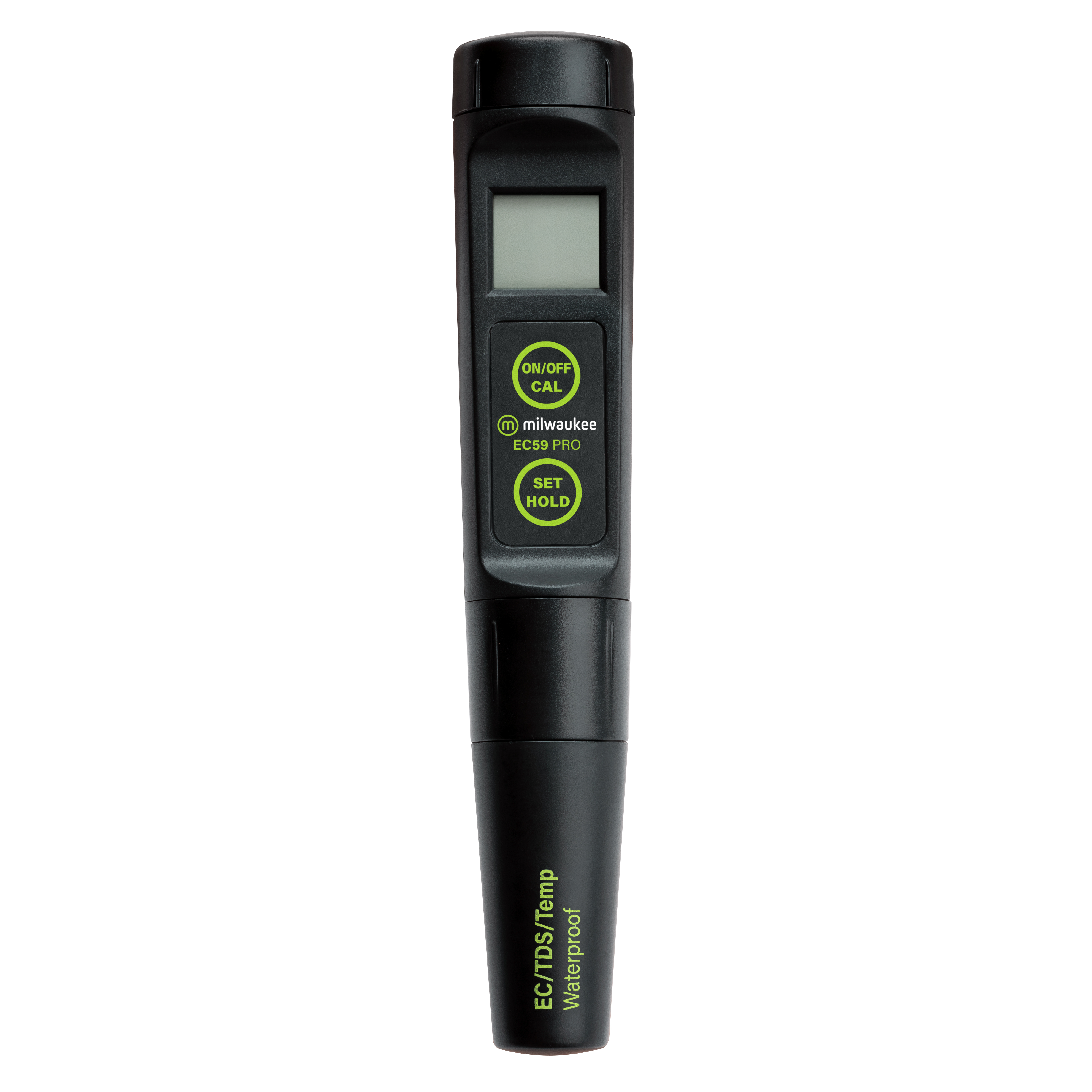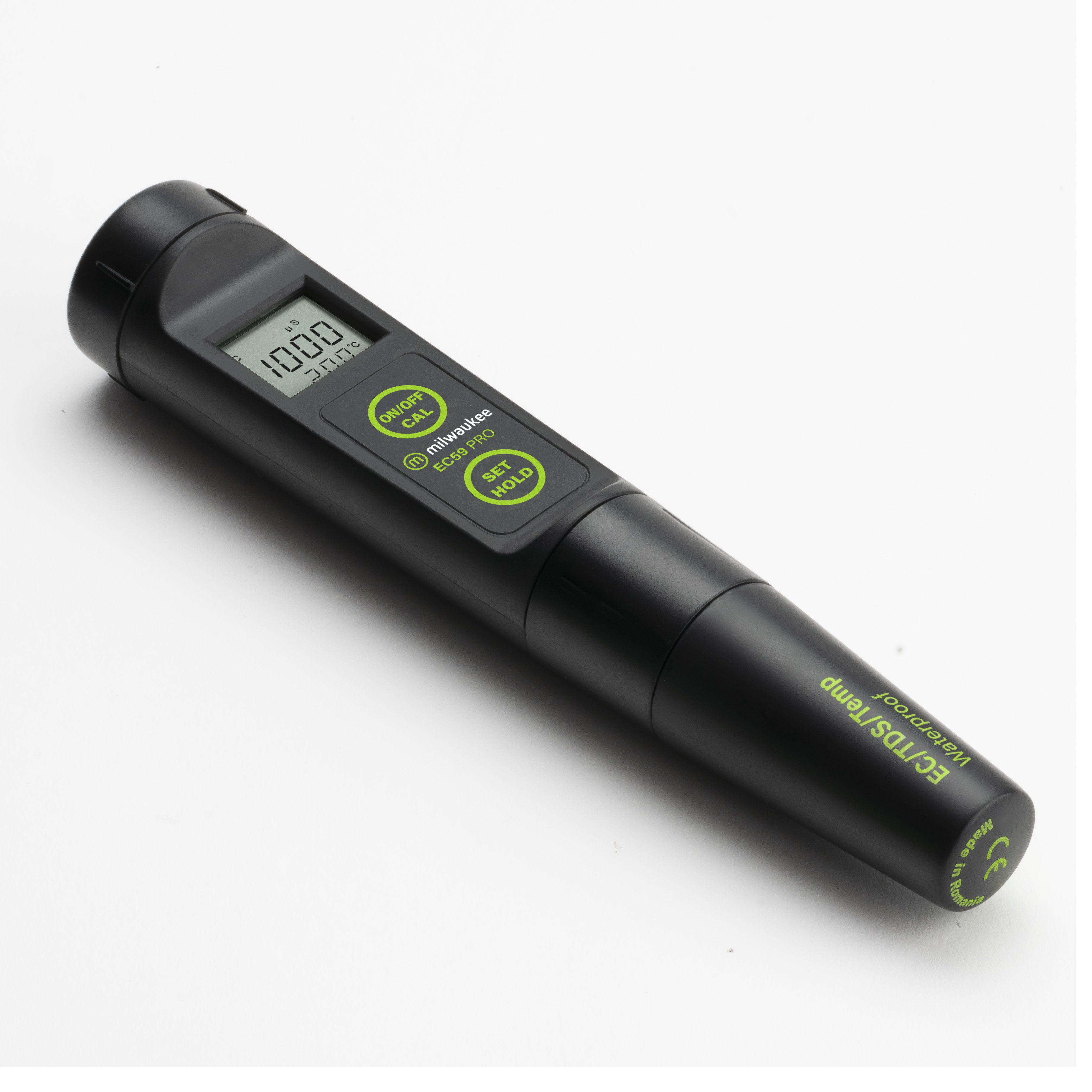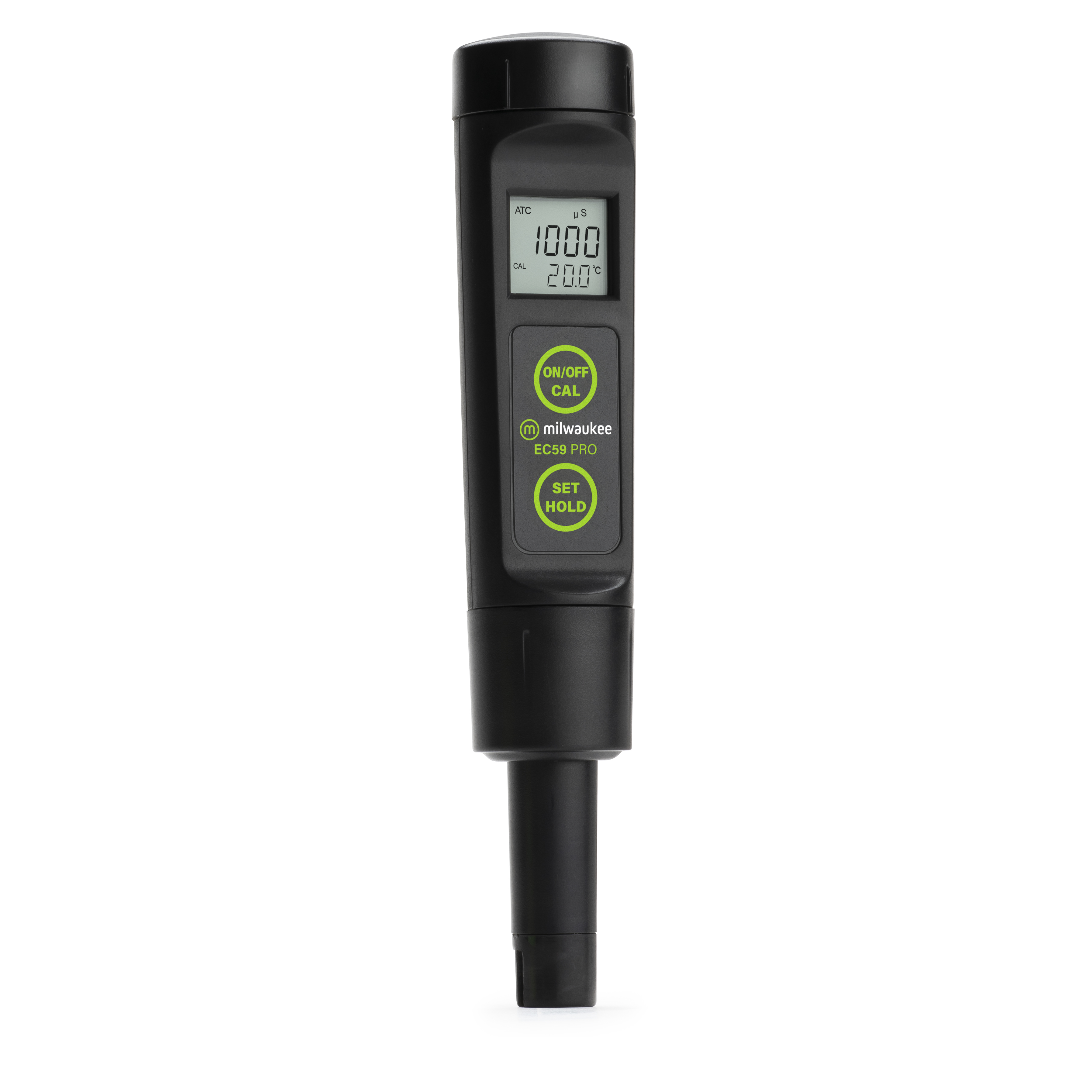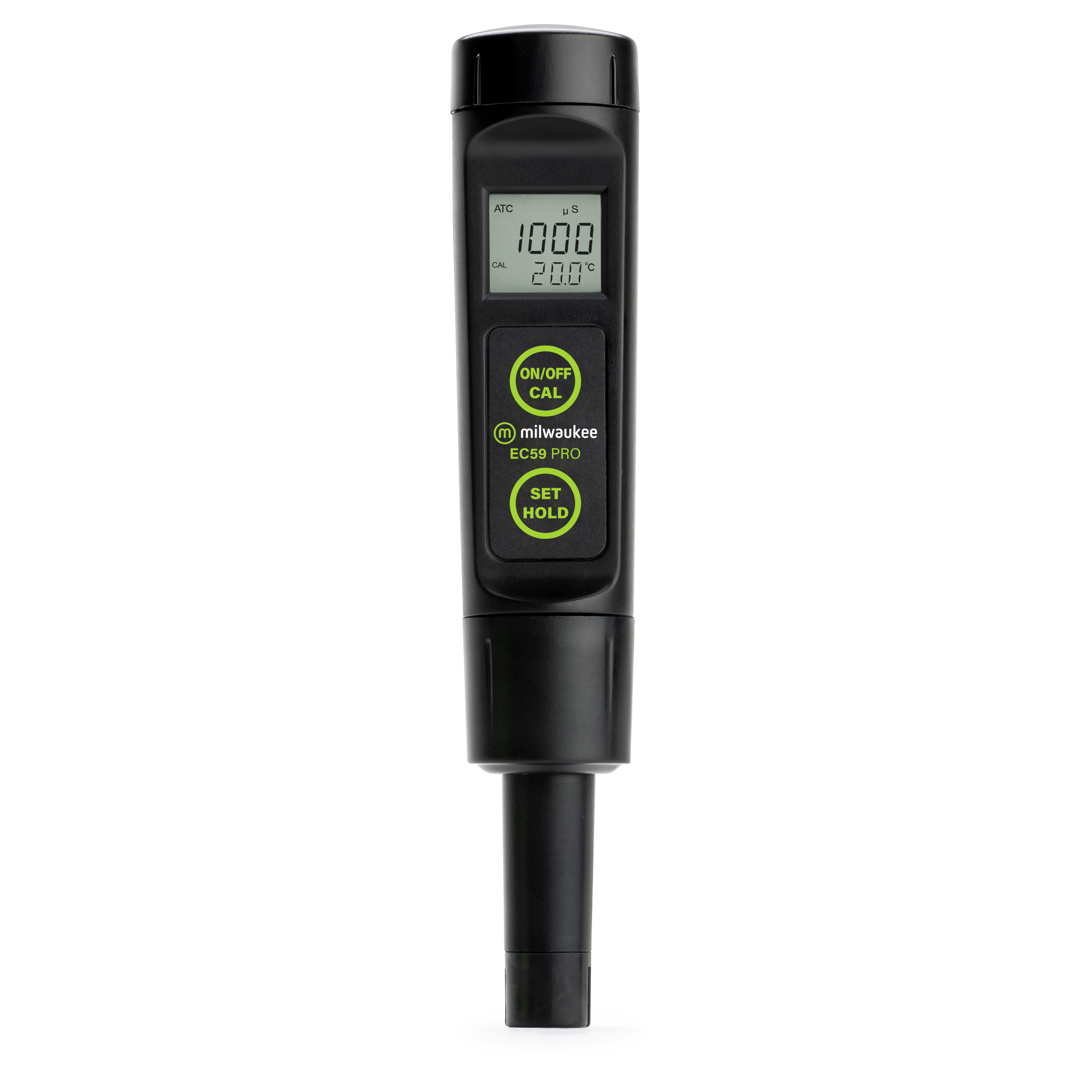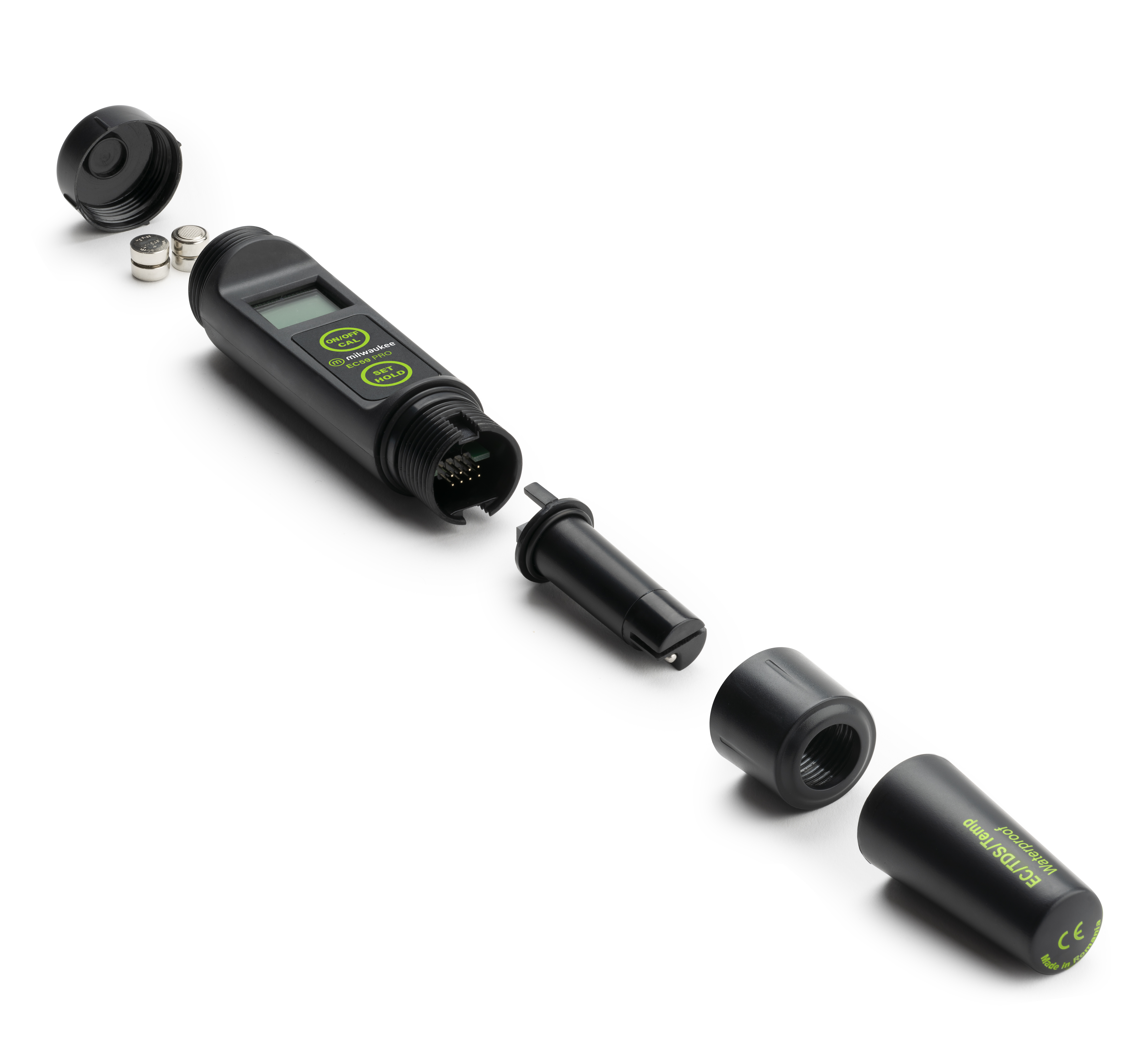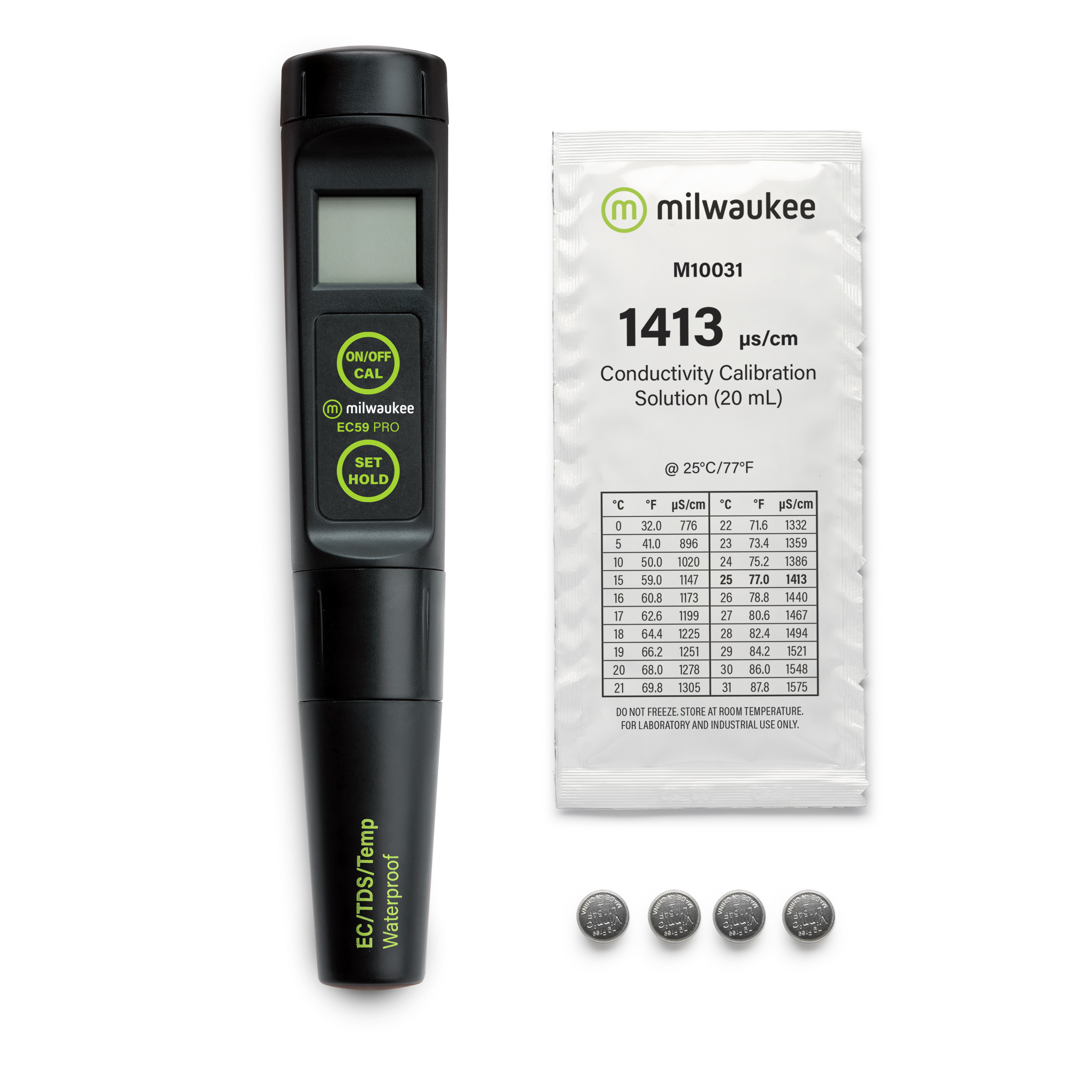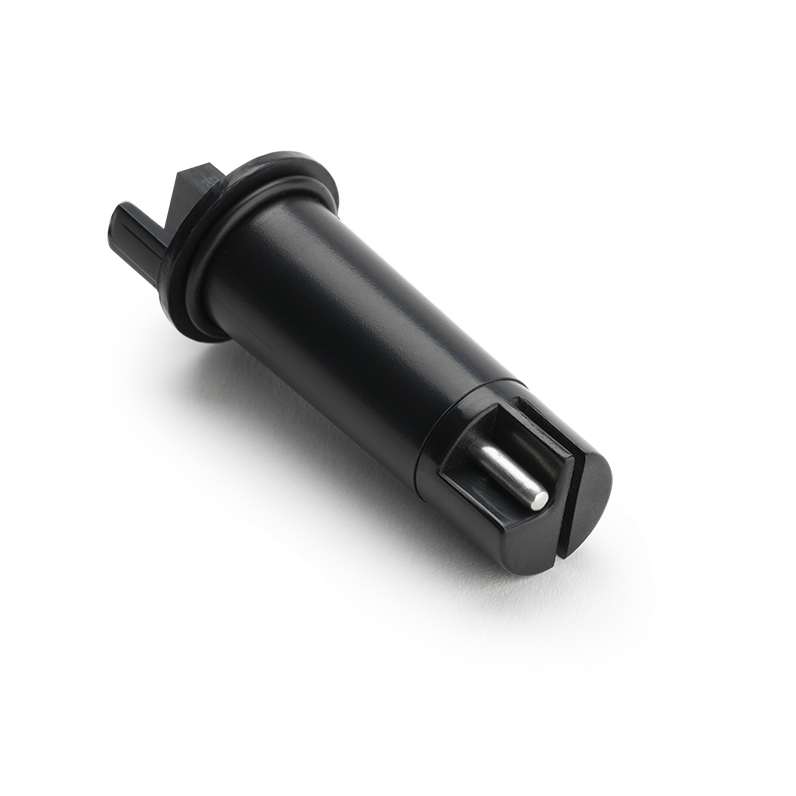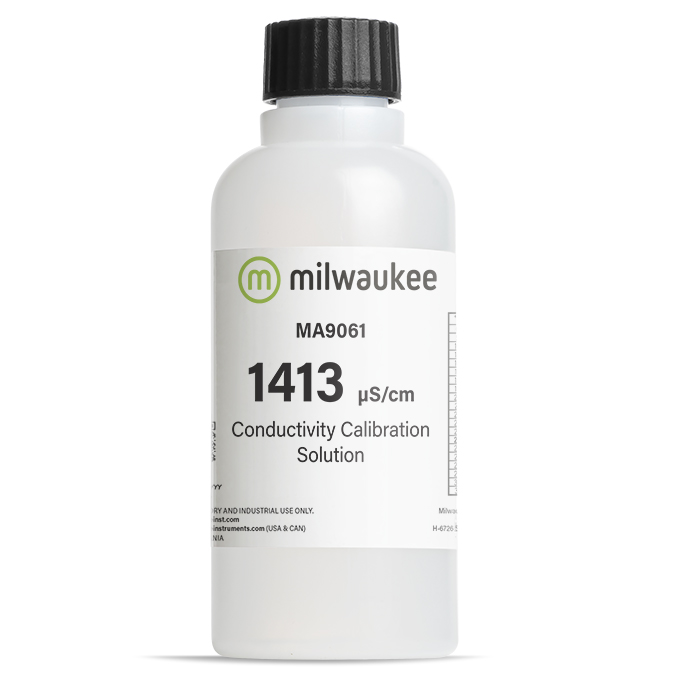Your shopping cart is currently empty.
€77.25
Milwaukee EC59 PRO Waterproof 3-in-1 Conductivity / TDS & Temperature Tester with Replaceable Probe
Milwaukee EC59 Conductivity Tester – Precision and Reliability for All Water Quality Applications
The Milwaukee EC59 Conductivity Tester is an advanced tool designed for users who require accurate, reliable, and fast measurements of electrical conductivity (EC), total dissolved solids (TDS), and temperature. Whether you are managing a hydroponic farm, maintaining an aquarium, or monitoring water quality for environmental research, the EC59 provides exceptional performance in a variety of applications. With a rugged, waterproof design and a user-friendly interface, this tester ensures precision in every reading, helping you make informed decisions about your water quality.
Engineered for professionals and hobbyists alike, the Milwaukee EC59 is built to withstand harsh environments. The replaceable probe feature extends the life of the device, while the clear digital display allows for easy interpretation of results. With its versatile 3-in-1 functionality—measuring EC, TDS, and temperature—the EC59 is a comprehensive solution for anyone working with water quality across multiple industries.
Why Choose the Milwaukee EC59?
• Accurate Measurements: With a precision of ±2% Full Scale, the EC59 ensures reliable EC and TDS readings.
• User-Friendly Design: The intuitive interface and digital display allow for easy operation and result interpretation.
• Replaceable Probe: The durable, replaceable probe ensures longevity and cost-effectiveness.
• Waterproof Construction: Rated IP67, the EC59 is fully waterproof, making it ideal for field use in any weather conditions.
• Versatile 3-in-1 Testing: Measures EC, TDS, and temperature all in one compact device, streamlining your testing process.
• Automatic Temperature Compensation (ATC): Ensures accurate measurements regardless of temperature fluctuations.
• Long Battery Life: With efficient power management, the EC59 delivers up to 300 hours of continuous use on a single set of batteries.
Proper Care & Maintenance
To keep your Milwaukee EC59 Conductivity Tester operating at peak performance, proper maintenance is essential. Here are some simple tips to ensure long-lasting reliability:
• Rinse the Probe: Always rinse the probe with distilled or deionized water after each use to prevent contamination buildup.
• Dry Storage: Store the EC59 in a dry place to preserve probe sensitivity and prevent any moisture-related issues.
• Calibration: Calibrate your EC59 regularly using conductivity standard solutions to maintain measurement accuracy.
• Replace the Probe: If the probe shows signs of wear or damage, replace it to ensure continued accurate readings.
• Avoid Over-Immersion: Do not immerse the tester beyond its maximum immersion level to protect the electronics.
• Battery Replacement: Replace batteries when the low battery indicator appears to ensure consistent performance.
By following these simple care guidelines, you can extend the life of your Milwaukee EC59 and maintain its high level of accuracy for years to come.
CONVERTING EC TO TDS
The Milwaukee PRO Conductivity Tester, like all conductivity meters, provides a measure of electrically charged ions in a solution and is an absolute measure of conductivity.
EC/TDS can converted. Different scales include the 500 scale, 650 scale and the 700 scale.
Your uS/cm reading can be approximately converted to other scales as shown in the examples below.
2.00 mS/cm = 2000 uS/cm = 1000 ppm on .50 factor scale
2.00 mS/cm = 2000 uS/cm = 1400 ppm on the 442 scale or .70 factor scale
Specifications
Application
Agriculture & Hydroponics
In both hydroponics and traditional agriculture, the balance of nutrients plays a vital role in ensuring healthy plant growth. The EC59's ability to measure Electrical Conductivity (EC), Total Dissolved Solids (TDS), and temperature gives growers an invaluable tool for maintaining the ideal nutrient concentration. Whether you're growing in a hydroponic system or monitoring soil salinity, the correct levels of dissolved salts are crucial for plants to absorb nutrients effectively.
For hydroponic growers, nutrient solutions are carefully mixed to provide all the essential minerals plants need. The EC59 ensures that the nutrient concentration remains in the optimal range, helping to prevent nutrient deficiencies or excesses, which can harm plant growth. For soil-based agriculture, measuring soil salinity is equally important. High salinity levels can inhibit water uptake, reduce crop yields, and harm soil structure. By regularly monitoring the conductivity of the soil solution, you can make timely adjustments to irrigation or fertilization practices to safeguard the health of your crops.
With the EC59, you can quickly test your hydroponic solution or soil runoff to ensure the correct balance of nutrients and salinity, maximizing your plant's growth potential.
How to Use for Agriculture & Hydroponics:
- Calibration: Start by calibrating your EC59 with a conductivity standard solution to ensure accuracy. Calibration ensures your readings are precise for both EC and TDS measurements.
- Rinse the Probe: Before and after testing, rinse the probe with distilled or deionized water to avoid cross-contamination between different solutions or samples.
- Submerge the Probe:
· For hydroponics: Submerge the probe into your nutrient solution, ensuring it is fully immersed but not touching the container's sides.
· For soil: Collect a sample of the soil runoff or use a soil solution extract. Insert the probe into the sample.
- Stabilize the Reading: Hold the probe steady and wait for the reading to stabilize. This may take a few seconds to a minute.
- Interpret the Results: Compare your EC or TDS readings to the recommended levels for your specific crop or growing stage. The EC59 will also show the temperature of your solution, which can impact nutrient absorption.
- Adjust Nutrient Levels: If your readings are outside the desired range, adjust the nutrient concentrations or soil management practices accordingly to maintain optimal growing conditions.
By following these steps, you’ll be able to maintain healthy plants and optimize your yield in both hydroponic and soil-based systems. Regular monitoring with the EC59 gives you the confidence to create the ideal growing environment for your plants, ensuring they receive the nutrients they need for healthy, vigorous growth.
Aquariums & Fish Farming
Water quality is a critical factor in maintaining a healthy environment for aquatic life, whether in freshwater or saltwater systems. The EC59 is an essential tool for aquarium enthusiasts and fish farmers alike, as it measures conductivity, a key indicator of the dissolved salts in water. In both marine and freshwater setups, proper salinity and dissolved salt levels are crucial to the health and wellbeing of aquatic species.
In marine aquariums and fish farms, maintaining the right salinity levels ensures that fish, corals, and other marine life thrive. For freshwater aquariums, monitoring the conductivity can provide insights into the presence of dissolved minerals and salts, ensuring a balanced environment for species like freshwater fish, plants, and invertebrates. By regularly measuring conductivity, hobbyists and fish farmers can detect any fluctuations or imbalances in water quality that could lead to stress or disease in the aquatic population.
Whether you’re an aquarium owner or a fish farmer, the EC59 helps ensure a stable, healthy aquatic environment by offering real-time insights into salinity and conductivity, helping to prevent potential water quality issues before they affect the ecosystem.
How to Use for Aquariums & Fish Farming:
- Calibration: Before using the EC59, calibrate it with a standard conductivity solution to ensure accurate readings. Calibration is crucial for precise measurements of conductivity and salinity.
- Rinse the Probe: Always rinse the probe with distilled or deionized water before and after use to avoid contamination between different water samples.
- Submerge the Probe:
· For freshwater systems: Place the probe into the aquarium water, ensuring it is fully immersed but not touching the glass or other surfaces.
· For saltwater systems: Similarly, submerge the probe into the water to measure conductivity and salinity levels, keeping it away from direct contact with any rocks or corals.
- Stabilize the Reading: Allow the probe to stabilize for a few seconds to ensure an accurate reading. The EC59 will display both conductivity and temperature, which are important factors in assessing the overall water quality.
- Interpret the Results: Compare the conductivity readings to the recommended levels for your specific aquatic species. For marine aquariums, the salinity should fall within the ideal range for the species being kept, while freshwater aquariums require slightly different conductivity levels based on the fish and plants.
- Monitor Changes: Regularly check the conductivity and salinity readings to detect any sudden changes that might indicate water quality issues such as the buildup of pollutants, imbalanced nutrient levels, or salinity shifts. Consistent monitoring helps prevent stress, disease, and mortality in your aquatic life.
By following these steps, aquarium owners and fish farmers can ensure a stable and healthy environment for their aquatic species. The EC59 empowers users to keep the water quality at optimal levels, promoting healthy, thriving fish and marine life.
Environmental Monitoring
Conductivity measurement plays a vital role in assessing the health of natural water bodies such as rivers, lakes, and oceans. Changes in conductivity can indicate the presence of pollutants, chemical spills, agricultural runoff, or other forms of contamination. By tracking conductivity levels, environmental researchers and conservationists can detect early signs of water quality deterioration, allowing for timely intervention to protect ecosystems.
Healthy water ecosystems rely on stable conductivity levels, which reflect a balanced concentration of dissolved salts and minerals. Significant deviations from normal conductivity ranges can stress aquatic life, reduce biodiversity, and disrupt entire habitats. Regular conductivity monitoring helps maintain the sustainability of these natural environments, supports conservation efforts, and assists in ensuring that human activities do not negatively impact fragile ecosystems.
The EC59 provides an accessible and reliable way to monitor conductivity in various environmental settings, offering real-time data essential for informed environmental management decisions.
How to Use for Environmental Monitoring:
- Prepare the EC59: Before heading into the field, calibrate the EC59 with a standard conductivity solution to ensure accurate measurements. Field calibration is especially important due to varying environmental conditions.
- Rinse the Probe: Always rinse the probe with distilled or deionized water before taking measurements to avoid cross-contamination between different sites.
- Sample the Water:
· For shallow bodies like rivers or lakes: Submerge the probe directly into the water, ensuring it is fully immersed but not touching the riverbed, rocks, or vegetation.
· For coastal or ocean monitoring: Use a clean container to collect a water sample, then immerse the probe in the sample if direct access to the water body is not safe.
- Allow the Reading to Stabilize: Hold the probe steady in the water and wait a few seconds for the EC59 reading to stabilize. It will display the conductivity and temperature of the water, both important for comprehensive water quality analysis.
- Record the Results: Log the conductivity readings along with the date, time, location, and any notable environmental conditions (e.g., recent rainfall, visible pollution) to build a complete environmental monitoring record.
- Analyze Trends: Compare the current readings with historical data from the same site. Significant changes can indicate pollution events, seasonal changes, or shifts in land use around the water body.
- Follow Up if Needed: If abnormal conductivity levels are detected, conduct further testing or alert environmental authorities to investigate potential sources of contamination.
By following these steps, users can effectively monitor natural water bodies, helping to protect vital ecosystems and ensure water quality standards are maintained over time. The EC59 offers an easy-to-use solution for environmental professionals, researchers, and conservation volunteers alike.
Water Treatment & Purification
In water treatment and purification processes, monitoring conductivity is essential for ensuring water quality and system performance. Conductivity measurement provides a quick and reliable indication of the total dissolved solids (TDS) in the water. As water passes through filtration or purification systems, a significant drop in conductivity typically indicates effective removal of impurities. Conversely, rising conductivity levels can signal filter degradation, membrane failure, or contamination issues.
Water treatment facilities, whether for drinking water, industrial processes, or wastewater management, must meet strict regulatory standards. Consistent conductivity monitoring helps operators maintain compliance and detect operational problems early, preventing costly system failures or health risks.
Using a portable meter like the EC59 enables easy, on-the-spot checks of different stages in the treatment process, supporting continuous quality assurance and maintenance efforts.
How to Use for Water Treatment & Purification:
- Calibrate the EC59: Before measurements, calibrate the EC59 using a certified conductivity calibration solution to ensure precision, especially when checking for subtle changes in water quality.
- Rinse the Probe: Use distilled water to rinse the probe before and after each measurement to avoid residue buildup that can affect readings.
- Select Measurement Points:
· Measure the conductivity of raw (untreated) water entering the system.
· Measure the conductivity of treated water after it passes through filters, membranes, or purification units.
- Submerge the Probe: Immerse the EC59 probe into the water sample or directly into the stream if safe and accessible. Ensure it is fully submerged without touching the container sides or bottom.
- Stabilize and Read: Allow the reading to stabilize, then record both the conductivity and temperature displayed by the meter.
- Compare Results:
· A significant reduction in conductivity from the untreated to treated water confirms that the system is operating effectively.
· An unexpected rise or insufficient reduction may indicate filter saturation, membrane fouling, or system malfunction.
- Routine Monitoring: Conduct regular conductivity checks at scheduled intervals to monitor performance trends and plan maintenance proactively, reducing the risk of system failures or non-compliance with standards.
- Take Action When Necessary: If abnormal readings are observed, inspect and service filtration or purification components promptly.
By integrating conductivity monitoring with daily operations, water treatment professionals can safeguard water quality, optimize system maintenance, and ensure compliance with health and environmental standards — all supported easily with the reliable performance of the EC59.
Food & Beverage Industry
In the food and beverage industry, water quality plays a crucial role in maintaining product consistency, taste, and safety. Water is often used as an ingredient, for equipment cleaning, and for sanitation processes. Measuring conductivity is a simple yet effective way to monitor the purity of water, detect contamination, and verify the proper concentration of cleaning and sanitizing solutions.
High-quality water helps ensure that the final product meets strict quality standards, while effective sanitation safeguards against microbial contamination and preserves the integrity of production lines. In both cases, conductivity meters like the EC59 offer fast and reliable checks, supporting quality control, safety, and regulatory compliance in food and beverage operations.
How to Use for Food & Beverage Industry:
- Calibrate the EC59: Always calibrate the meter with an appropriate conductivity calibration solution before use to guarantee accurate readings.
- Rinse the Probe: Use distilled water to rinse the probe before and after each measurement to avoid cross-contamination between samples.
- Water Quality Testing:
Collect a sample of the water used for production.
· Immerse the EC59 probe into the sample, ensuring full submersion without touching the container’s sides or bottom.
· Allow the reading to stabilize, then record the conductivity and temperature.
· Compare the result to the required standards for production water. Higher conductivity may indicate contamination with minerals or impurities that could affect product quality.
- Cleaning Solution Monitoring:
· After preparing cleaning or sanitation solutions, test a sample to verify that the concentration matches the required specifications.
· Insert the probe into the cleaning solution, let the reading stabilize, and note the conductivity.
· Reference the manufacturer's guidelines for the correct conductivity range of the solution.
- Routine Checks: Regularly monitor water and cleaning solutions during production shifts to maintain consistent quality and ensure safety protocols are being met.
- Respond to Deviations: If conductivity values are out of range, take corrective action immediately—this could mean adjusting solution concentrations, replacing water supplies, or investigating equipment issues.
By incorporating conductivity measurements into everyday operations, food and beverage producers can confidently maintain high standards for both product excellence and hygiene, supported by the easy-to-use and accurate EC59 meter.
Swimming Pools & Spas
In swimming pools and spas, maintaining proper water chemistry is vital for user safety, equipment longevity, and overall enjoyment. Conductivity measurement helps ensure the correct salt concentration in saltwater pools, which is critical for chlorine generators to function effectively. In both saltwater and traditional pools, conductivity monitoring can also provide insight into the overall water quality, helping to detect imbalances that could lead to cloudy water, corrosion, or ineffective sanitation.
By regularly checking conductivity levels, pool and spa operators can maintain the ideal environment, ensuring clean, clear, and safe water while minimizing the risk of skin irritation, eye discomfort, or the growth of harmful bacteria.
How to Use for Swimming Pools & Spas:
- Calibrate the Meter: Before use, calibrate the EC59 or other conductivity meter with a standard calibration solution to ensure precise readings.
- Prepare for Testing: Rinse the probe with distilled water to remove any residues that could interfere with accuracy.
- Measure Salt Concentration:
· Take a water sample from a well-circulated area of the pool or spa.
· Immerse the probe completely into the sample, avoiding bubbles or contact with the container sides.
· Wait for the reading to stabilize, then record the conductivity value.
· Compare the result to the recommended salt level for the specific chlorine generator (usually between 2,500–3,500 ppm).
- General Water Quality Monitoring:
· Conductivity measurements can also reveal changes in overall water balance.
· Regularly check water samples, especially after heavy pool use, rain, or refilling.
· Sudden increases or decreases in conductivity may signal contamination, chemical imbalances, or dilution.
- Maintenance Actions:
· If salt levels are too low, add salt according to manufacturer recommendations.
· If levels are too high, partially drain and refill the pool to dilute excess salts.
· Address any conductivity changes promptly to maintain ideal sanitation conditions and avoid equipment damage.
- Rinse and Store: After measurements, rinse the probe with distilled water and store the meter properly to prolong its lifespan.
By integrating conductivity checks into regular pool and spa maintenance, users can keep water sparkling clean, extend equipment life, and ensure a safe, pleasant swimming environment.
Laboratory & Educational Use
In laboratory and educational settings, conductivity measurement serves as a fundamental tool for understanding the chemical properties of liquids. Measuring conductivity offers a simple, reliable method to determine the concentration of ions in a solution, supporting a wide range of experiments and tests. It is widely used in general chemistry education to teach students about electrochemistry, ionic mobility, and the relationship between dissolved substances and electrical conductivity.
For research laboratories, precise conductivity measurements are essential in fields such as environmental science, biology, material science, and chemical engineering. Whether used in student exercises or professional studies, conductivity testing helps develop a deeper understanding of solution chemistry and promotes accurate experimental results.
How to Use for Laboratory & Educational Applications:
- Calibrate the Meter: Always begin by calibrating the conductivity meter with an appropriate standard solution to ensure measurement accuracy.
- Prepare the Sample:
· Use clean, deionized, or distilled water to rinse the probe before testing.
· If necessary, prepare your solution under controlled conditions to avoid contamination.
- Measure Conductivity:
· Submerge the probe fully into the liquid sample, ensuring it does not touch the sides or bottom of the container.
· Stir gently if needed to avoid air bubbles.
· Allow the reading to stabilize before recording the conductivity value.
- Educational Demonstrations:
· Use measurements to show how adding salts (like NaCl) or acids and bases affects conductivity.
· Perform comparative tests with distilled water, tap water, and saline solutions to illustrate the relationship between ion concentration and conductivity.
- Data Interpretation:
· Discuss how conductivity changes correspond to changes in ionic strength.
· Explore factors like temperature, type of ions, and concentration as part of the learning objectives.
- Maintenance:
· After each measurement, rinse the probe with distilled water to prevent contamination or buildup.
· Store the conductivity meter according to the manufacturer's recommendations for long-term accuracy.
By integrating conductivity measurements into laboratory experiments and educational programs, students and researchers gain hands-on experience with critical chemical analysis techniques and build a strong foundation in electrochemical principles.
Industrial Applications
In industrial environments, monitoring conductivity is essential for maintaining the efficiency, safety, and quality of water-based systems. Conductivity measurement helps prevent issues such as corrosion, scaling, and fouling in critical equipment like boilers, cooling towers, and piping systems. By keeping conductivity within target ranges, industries can extend equipment life, reduce maintenance costs, and ensure compliance with safety and performance standards.
Additionally, many industrial manufacturing processes — including electronics production, food processing, and pharmaceuticals — require water of specific purity levels. Regularly checking conductivity ensures that the water used in these processes meets the necessary quality standards, ultimately protecting product integrity and operational efficiency.
How to Use for Industrial Applications:
- Calibration:
· Calibrate the conductivity meter with a standard solution appropriate for the expected conductivity range in your system.
- Sample Collection:
· Collect water samples from different points in the system, or, for continuous monitoring, install the conductivity sensor inline according to manufacturer instructions.
- Measurement:
· Immerse the probe fully into the sample or start the reading if installed inline.
· Allow the meter to stabilize before recording the conductivity value.
- Interpret Results:
· Compare the measured conductivity against industry standards or system-specific guidelines.
· High conductivity may indicate an excess of dissolved solids, leading to scaling or corrosion risks.
· Low conductivity may point to insufficient treatment or a malfunction in water purification systems.
- System Adjustments:
· Based on the readings, adjust chemical treatments, blowdown rates (in boilers), or filtration processes as needed to maintain optimal water conditions.
- Routine Maintenance:
· Regularly clean and calibrate the conductivity probe to ensure ongoing accuracy, especially in environments with heavy contamination or chemical exposure.
Accurate conductivity monitoring in industrial systems not only protects expensive infrastructure but also supports the production of high-quality goods and compliance with regulatory requirements.
Drinking Water Quality
Ensuring access to clean, safe drinking water is critical for public health. Conductivity measurement offers a fast and effective way to assess the purity of potable water. Elevated conductivity levels can signal the presence of dissolved minerals, salts, or contaminants that may compromise water quality.
By routinely measuring conductivity, water suppliers, treatment facilities, and even households can detect changes in water composition that might indicate filtration system failures, contamination, or mineral imbalances. Additionally, conductivity monitoring plays a crucial role in the operation of desalination systems, helping to verify that water meets the strict standards required for safe human consumption.
How to Use for Drinking Water Quality:
- Calibration:
· Calibrate the conductivity meter using a certified standard solution close to the expected drinking water range (usually low conductivity levels).
- Sample Collection:
· Collect a fresh water sample from the tap, filtration output, or storage tank in a clean, contaminant-free container.
- Measurement:
· Immerse the conductivity probe fully into the sample.
· Allow the reading to stabilize before recording the value.
- Interpret Results:
· Compare the measured conductivity to local or international drinking water standards (e.g., WHO recommends a maximum of 400–500 μS/cm).
· High conductivity readings may indicate excess salts, minerals, or contamination, requiring further testing or corrective action.
- System Monitoring:
· Use regular measurements to monitor the performance of filtration and desalination units.
· A gradual increase in conductivity can signal that filters need replacement or that maintenance is required.
- Maintenance:
· Clean and calibrate the conductivity probe regularly to maintain accurate and reliable measurements, especially in areas with high mineral content.
Routine conductivity testing helps protect the health of consumers by ensuring that drinking water remains pure, safe, and within regulatory limits.



